Project Boards and Project Steering Groups: An Introduction
This blog is reader-supported. When you purchase something through an affiliate link on this site, I may earn some coffee money. Thanks! Learn more.
Who on your project will have the authority to make decisions at the most senior level? Who will get you access to the resources you require? Who will unblock problems and sign off the extra money the project needs?
These are all functions of a project board (or steering group). Strong leadership in projects is important for success, so getting your project board and/or project steering group set up as soon as you can is a good start.
Here’s an introduction to these important groups as part of the governance framework so you can get yours set up and working on your project.
In this article we’ll look at what is a project board, and other names they are known by, who should be there, when to schedule meetings, what to talk about, how to report to this group and lots more so you can make sure it’s working effectively and efficiently.
What is a project board?
A project board provides oversight and governance for the project. It is made up of people who have an interest in the project: representatives from each of the key stakeholder communities, who meet on a regular basis to provide direction, authority to proceed and to decide on the strategy for the project. They should help guide you to project success.
In other words, this is the group that takes the tough decisions. They let you know whether you can go overspent or what risk mitigation actions are the right ones for this point in the project. And will make the decision to close the project down early if it can no longer meet its objectives.
If you can’t deal with a problem yourself, you can take recommendations to the project board and they will be able to resolve it for (or with) you.
At least, that’s the theory! They will need your support, guidance and information to make an informed decision on next steps.
What is a project steering group?
Some projects have a project steering group as well as a project board.
In this structure, the steering group (also known as simply ‘steering’) is the next level up oversight committee for a project. They may meet just to discuss your project, or they might be the accountability layer for several projects and meet to discuss them all during an extended meeting.
The steering group might be the program board: your project has it’s own governance, assurance and accountability set up, that reports into the program board that does the same role for the whole program. There are lots of models: it’s really very tailorable.
Do I need a project board or a steering group?
What you need is adequate governance for the project. Call your meetings anything you like. Have as many layers as fits within your PMO methodology.
You might use the term project board or governance committee, steering group, steering committee or something else that means a similar thing. All projects should have one, but the make up and naming of the group depends on your organization.
For the purposes of this article, we’re going to assume you’re following the common governance structure of a project board for day-to-day oversight and also a higher-level steering group for executive assurance.
It’s totally fine just to have one though. Many, many projects only have one level of governance and call it the steering group. Let’s not get hung up on terminology.
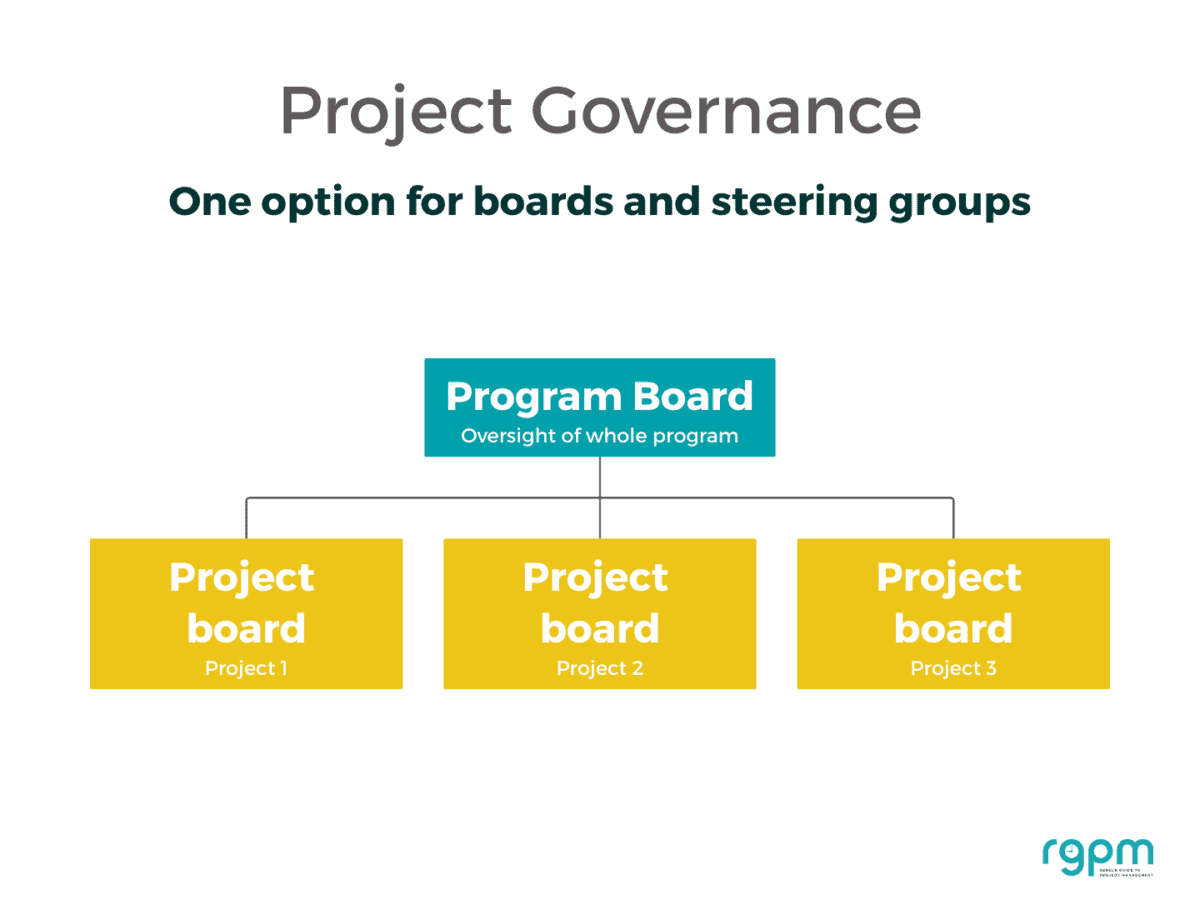
Responsibilities of the project board/steering group
You’ll want to document a terms of reference for your governance committees so they know what they are supposed to do. Here’s an overview of their responsibilities:
- Individual members and the group overall champion the project including raising awareness of it and any issues at senior level
- Ensure the project remains focused on the scope
- Ensure the project is set up for success, by providing guidance
- Ensures the project adheres to organizational procedures, policies, frameworks, regulation etc.
- Keeps the project team ‘honest’ by monitoring and controlling (at a high level) to keep the project on track
- Authorizes the project to continue to the next stage (or sends it back for more work to be done before authorization is given)
- Releases funds on a phased basis, according to the governance structure set up
- Approves changes, variations to scope and schedule (those that have a high impact), including reviewing recommendations from the project manager and team
- Approves deliverables and provides authorization and sign off as required for project management documents and other artifacts.
Who attends the project board?
The main roles attending the project board are:
Senior customer: the person representing the internal or external client. Often the project sponsor.
Senior supplier: the person representing the group doing most of the work. Often an internal senior department manager, client account manager or supplier project manager/representative.
Project manager: the person leading the project (you).
That’s the minimum (and the approach advocated by PRINCE2). However, in real life, you’ll have more than one team involved in project execution and delivery, so senior management reps from each area might attend.
Equally, large projects affecting several areas may need representation and support from each area.
Project boards can include anyone else who has a significant vested interest in the way the project is run, the delivery of the project scope, and the decisions that are taken.
Examples would be:
- A vendor account manager
- The key customer or their representative, especially if this is a senior manager from another internal department
- A finance or legal team member, if the project has significant impact in those areas
- Someone like an Operations Director, if the project is going to change the way the Operations area of the business is run through the introduction of a new front-line process, for example.
The people on the project board need to be relatively senior people, with the authority to make decisions and allocate resources. Your project sponsor should be the chair, although in some organizations you might chair it as the project manager.
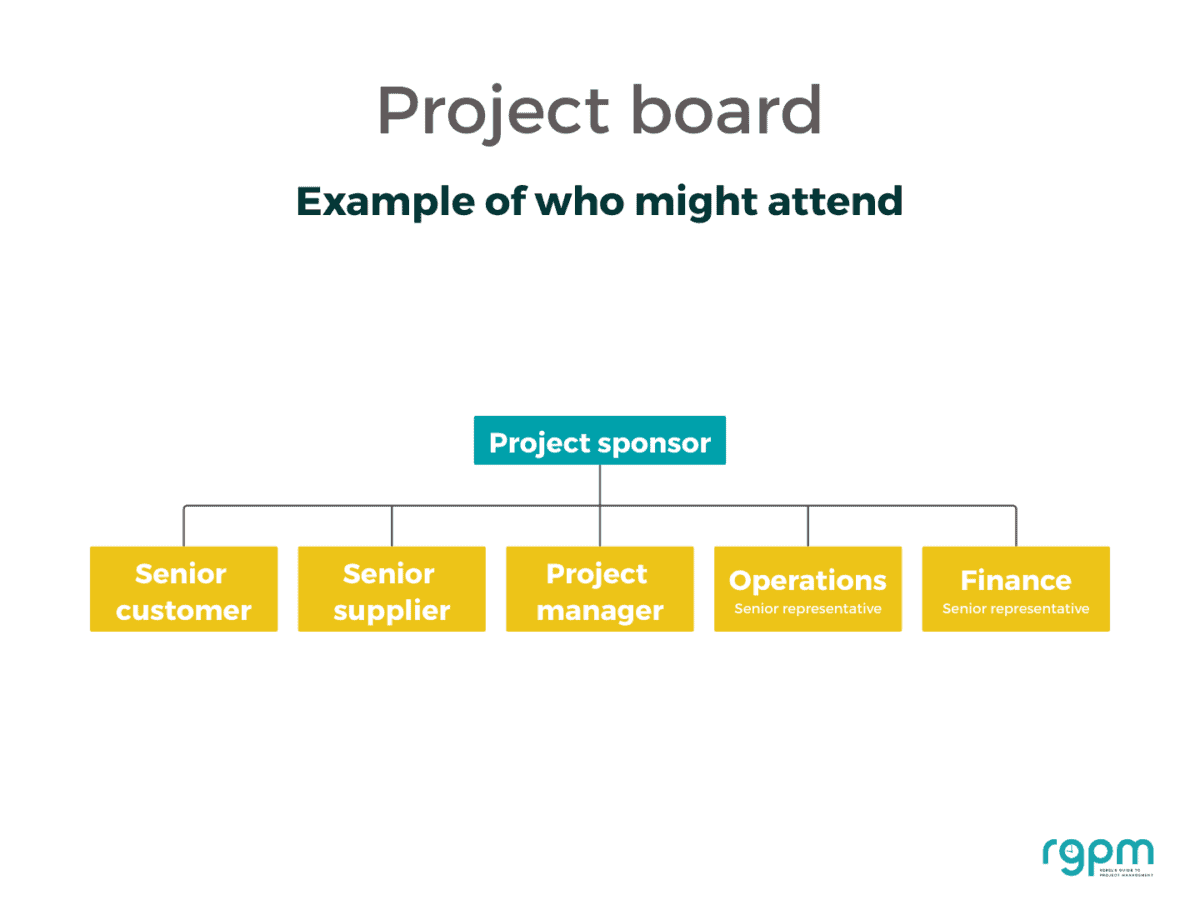
Who attends the steering group?
If you have an exec steering committee, the members are normally the next management level up from your project board members.
For example, on one project, I had the CFO steering group, and attendees were all SLT (senior leadership team members). It was a much smaller group, and focused on strategic decision making instead of day-to-day problem solving and risk management.
Of course, the project manager should attend too.
In every case, you should have people on the group who understand the project (or who can be brought up to speed) and who have influence and interest in the outcomes.
How often does the project board meet?
The group is a key part of your project governance framework. They can meet as often as you like. If you don’t know where to start, a monthly meeting is a good idea, and the minimum I recommend to my corporate and coaching clients.
On some projects it’s necessary for that group to get together fortnightly, especially if it’s a business critical project or a time of uncertainty for the organization.
On other projects that have a long duration and are relatively stable, a quarterly meeting is more than adequate.
Read next: The different types of project meetings you need to be having
You can always change the frequency of meetings once the project is up and running and you know how much assurance is going to be applicable. It’s fine to have a different cadence at different points in the project lifecycle.
When to hold the meetings
In a model where you are meeting once a month, I would hold the project board meeting in the first week of the month, to report on progress in the previous month.
If you have a project steering group as well, that should be scheduled for after the project board, so any issues that cannot be resolved by board members can be escalated in a timely fashion.
It’s useful to time meetings around significant other milestones, for governance purposes. For example, hold the meeting the week before you need approval to send out training material, or similar, so that the right people can make the decision there and then.
The best format for project board and steering group meetings
Should you have face to face meetings, virtual, hybrid or some other format?
The best format for project board and steering group meetings is the one that gets you done the most effectively.
You can decide on the best format for your meetings, although the sponsor will have a say too.
In my experience, face-to-face meetings are the most effective, as with all types of meetings, but it’s not always possible to do that. You might want to have a conference call line open so that people who aren’t present can join the meeting on the phone.
Or you might want totally virtual meetings – if that fits the culture of your business, go for it. It is certainly cheaper and easier than trying to get your senior leaders together in a room!
The best duration for project governance meetings
Start out by booking your meetings as an hour – no one really likes to be tied up for longer than that and your attendees are busy people with packed diaries.
However, be guided by the length of time it is taking to get through your agenda and alter the format and duration of the meetings as appropriate.
In some cases, you might decide that an hour and a half is a better time. If you know there isn’t much on the agenda, you can get away with 45 minutes, then do that! Everyone will be grateful to get a bit more time back in their day.
Agenda for a project board
Use a meeting agenda so that everyone knows the topics in advance and can prepare. Your agenda can be a standing format meaning that you cover the same topics every time the group meetings. Then you can add extra items in if necessary.
As a minimum, you should expect to cover these points in the meeting:
Project progress. While the Project Board are unlikely to want to go through the project plan in detail, make sure that you have access to your schedule during the meeting so that you can call up any task and provide a detailed update as required.
You probably won’t need to do this, but the meeting that you aren’t prepared for is the one where your sponsor will want real time information about task tracking!
Budget position. Senior leadership is always interested in how much money has been spent! Make sure you can present a summary of the project’s expenses.
Action updates. Go through the actions from last time and check that progress is being made.
Get a free template: Use my simple action log template to track actions from the meeting and report on them next time.
Risks and issues. The Project board doesn’t need to know about every risk and issue, but highlight the important ones that you think they should be aware of.
Key decisions. If you are expecting the project oversight committee to make a decision at the meeting, make sure that they have information in advance of your meeting so that they can review the different options. If you have put forward a recommendation, they’ll want to see that as well.
No one wants to feel put on the spot, so let them have time to think about what decision they want to come to, and use the meeting to finalize that, rather than spending all the time in a debate about options.
End the meeting with AOB as always.
These meetings should help you, as a project manager, because they give you the direction you need and the decisions required to keep the project moving forward. They can feel like a challenge because of the mix of people in the room, but overall they are a good thing for your project and show that there is adequate governance.
Agenda for a steering group
A steering group agenda is the same as for a project board:
- Welcome and intros
- Project progress and current status including financials
- Action updates
- Key decisions required
- Key risks and issues they need to be aware of or act on
- AOB.
Personally, I would send out the report in advance and assume everyone has read it (they won’t have). Then in your progress update, talk briefly about the things you want them to focus on, like areas where the team is stuck and waiting on them for some decision or action.
Make sure you have the latest info on project budgets and how close the project is to meeting its goals.
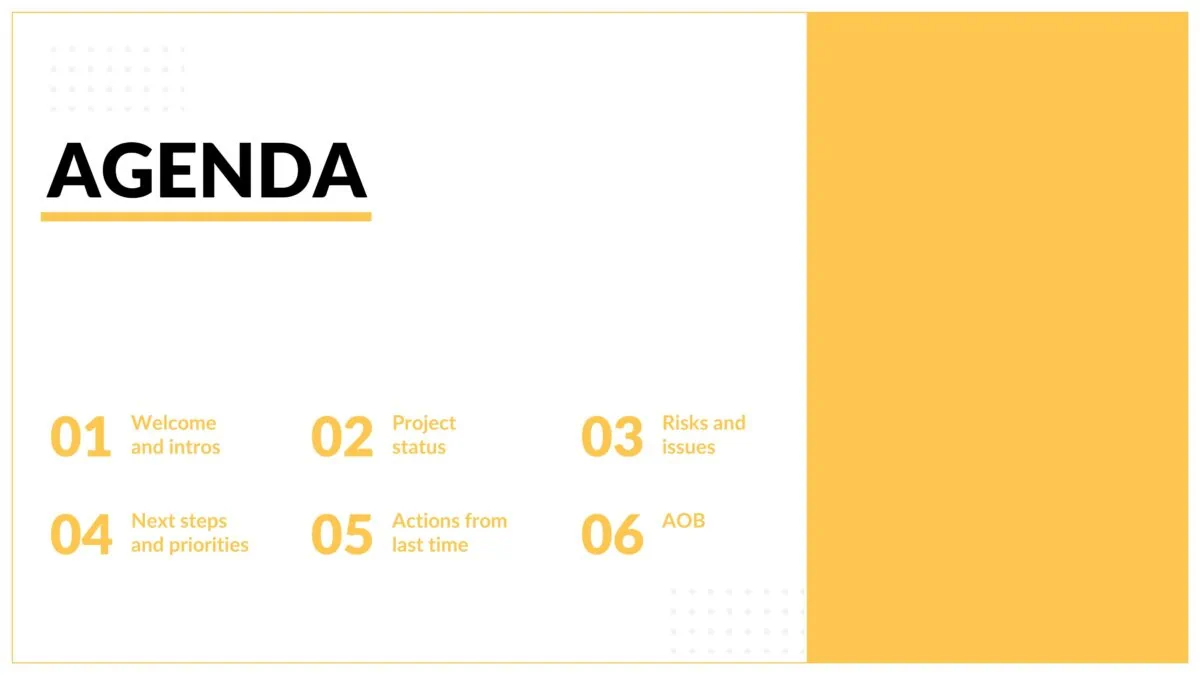
Example project board report template
A major part of any governance committee meeting is the project manager presenting progress and the other attendees holding the project manager to account with challenging questions. Be prepared to justify your decisions and explain any variances to plan!
The best way to avoid being grilled in a project board or steering group is to produce a decent report for them to read in advance.
Here’s what to include.
- Project status: summarize the status or use a dashboard template to sum up the progress
- Timeline: as a reminder of what we are doing and how long it’s going to take. Highlight anything that has changed since last time.
- Risks and issues: only the ones that you want to bring to their attention.
- Action review and next steps.
I also include a summary of what we’re doing and the project deliverables, because steering group members are busy people and it’s possible they’ve forgotten which one of their projects this is about.
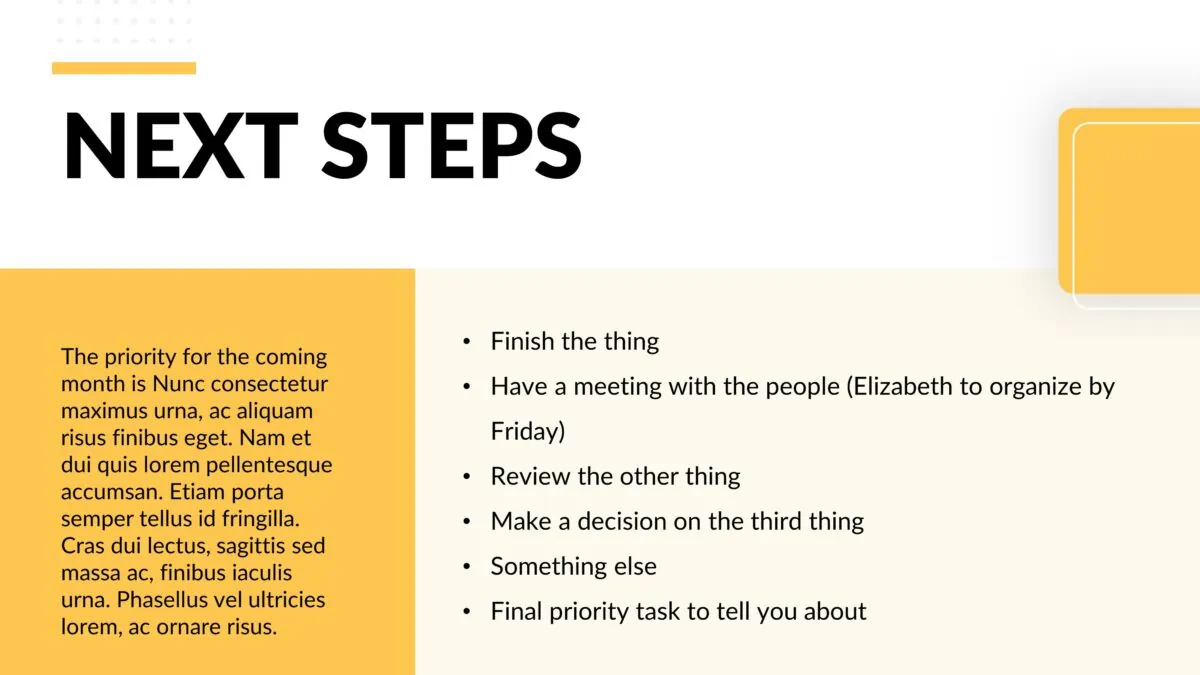
4 Reasons why your project board isn’t working
A survey by the Centre for Complexity and Change at The Open University found that a third of project managers are involved in the decision making process but are not the sole decision maker themselves*.
It’s essential that project boards are proactive in helping the project manager by considering recommendations and making decisions. Otherwise the work could be held up while the project team wait for a clear steer on the way forward.
However, just because a project has a project board doesn’t mean the group will be of value. Is yours helping or just taking up energy and space?
Here are four reasons why project boards fail to be effective.
1: No senior ownership
Symptoms: The project manager brings recommendations to the table but the project board fails to make decisions; decisions take a long time; decisions involve consulting other people not present during steering group meetings.
Take Action: Your project board is not made up of the right people. The decision makers on your project should be authoritative and have the ability to negotiate with other key departments in case of conflict.
Without a clear route for (binding) decisions, you could find your project stalling at the most critical moments, as the stakeholders disagree amongst themselves and refuse to abide by each others decisions.
Alternatively, the project board could be made up of too many people. It’s difficult to gain collective agreement with more than five or six people, so keep the group small. If, as project manager, you need to consult others, do so before the meeting and include their views in the recommendations you present to the committee.
2: No interest in the project
Symptoms: Meetings get cancelled; the project manager cannot get time with the project sponsor or project board members.
Take Action: Again, your project board is not made up of the right people. Why are they so disinterested? Somebody in the organization must have an interest in this project, or it would never have started.
The initiator may have moved on, and his or her successor may be unwilling to support the project for any number of reasons. A lack of interest in the project at senior level is a sign that company strategy has moved on.
Perhaps this project is no longer required, but no one has yet been brave enough to cancel it.
If your project board is unwilling to provide the required direction for the project, you can suggest that the project is stopped. If there are people out there who strongly believe that the project should continue, then they will come out of hiding and stand up for it.
If no one challenges your recommendation, then nobody cares enough for the work to continue. There is no point working on a project that serves no purpose, so bow out gracefully and support the project team in the transition to new, more relevant, projects.
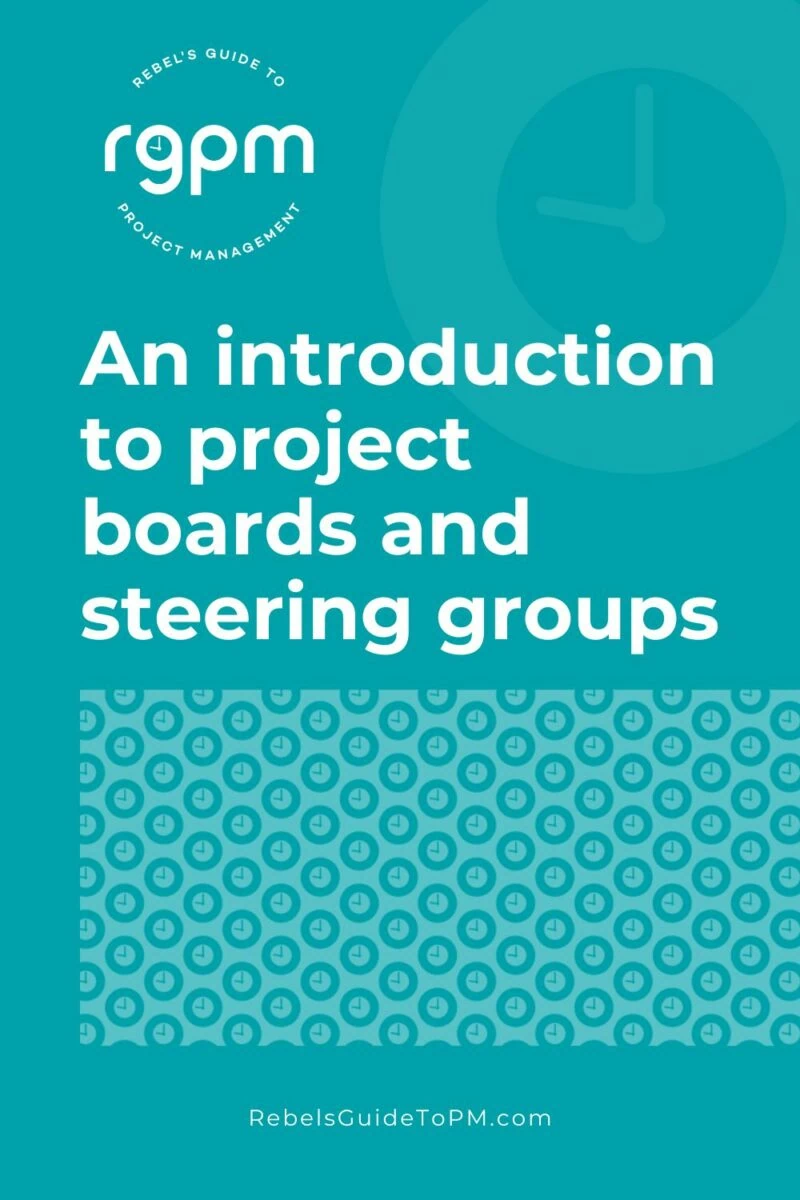
3: They are willing, but useless
Symptoms: Meetings are not structured; project board members are enthusiastic but do not follow through on delegated actions; roles and responsibilities are unclear.
Take Action: It sounds as if everyone believes this project is a good idea, but no one really knows what they are doing or why they are doing it. Address the ‘why’ first: spell out the benefits for each project steering member.
The sales director will be more focused on completing her actions if she understands that the web application will make it easier for sales staff to process orders out in the field. The compliance manager will make his team available to help if he understands how the new software tracking system will monitor license usage across the company.
Then address the ‘what’. Manage upwards to add some structure to the meetings.
Document the terms of reference for the group, with roles and responsibilities for each member.
Circulate an agenda, with the agreement of the sponsor. Take minutes, or co-opt someone from the PMO to help. Ensure the minutes are sent out, and actions have clearly identified owners and a date by when they need to be complete.
(Need help with minutes and agendas? My Meetings Template Kit has got you covered.)
Before the next meeting, ring round all the committee members to see if they have completed what they said they would. People are more likely to complete tasks if they understand the consequences of not doing them: if the project is important to them, they will do what they need to do to keep it on track.
If time is the problem, suggest they delegate the actions to a member of their team, although they should still attend the meetings themselves.
4: No sponsor
Symptoms: No one takes overall accountability; no one tracks benefits; no one will take ownership of the solution once it is in production.
Take Action: Typically, the sponsor is the person who came up with the idea for the project, holds the budget and will adopt the solution once it is live and moves out of the project arena. He or she is the customer for the project.
An absent sponsor is often the result of ‘slopey shoulders’. Being a sponsor is being responsible, and not everyone wants responsibility. “I think it’s a great idea, but you should champion it,” is the refrain.
As project manager, you need to advise upwards. Choose who should be sponsor (or take advice from senior managers) and take that person under your wing. Help the sponsor understand how the role supports the project team, and how responsibility isn’t a scary thing.
People in the role of sponsor also suffer from having many demands on their time and your project may not be top of the list. If they don’t know what it is they have to do, you can be sure they won’t make the time to find out.
The project manager should explain what is expected from them, and help them achieve that. You may also have to train your project sponsor in the technical details of the project to enable them to make appropriate decisions.
A project steering committee should be there to cut through political power games, which can significantly delay (or stall or close down) a project. Don’t put up with a failing board – as it only takes one important issue that isn’t handled properly before your project starts careering off the rails.
Your next steps
In this article, you’ve learned about the roles and responsibilities of a project board and project steering group, how to structure meetings and report to them, and why their role in project governance may not be as effective as it should be. Here’s what to do next.
- Decide on the governance structure for the project. Will you have a project board and steering group? What will you call them and who will be in them?
- Set up a meeting with your sponsor to review roles and responsibilities and agree the terms of reference for the group(s).
- If you already have these governance groups in place, assess if they are working for you or just filling up your calendar with pointless meetings. Consider what to do if they are ineffective.
- Create a standard agenda for each meeting and get a report template so you can make reporting progress easier.
Buy Strategies for Project Sponsorship on Amazon.co.uk
* White, D. and Fortune, J. (2002) Current practice in project management – an empirical study. International Journal of Project Management, 20.
Parts of this article first appeared on The ICPM website in 2008 and on this site in 2012.
